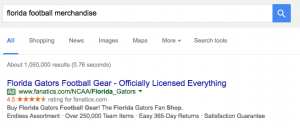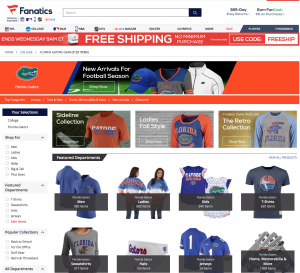As a marketer, and more specifically as someone who has specialized in Search Engine Optimization for the last 5+ years, I’ve heard the phrase “Content is King” more times than I can count. I don’t disagree that content is of vital importance because content is the most effective way to attract and engage an audience. However, what I am saying is that the real king of the Internet is context.
As I scrolled through my Facebook feed last week I was confronted with an advertisement. Obviously this is a regular occurrence. As frequent Internet users, we are consistently bombarded with a myriad of advertisements every day; however, this particular advertisement stopped me in my tracks. There was only one thing that made this ad stand out from the rest: context.
To explain why this advertisement had such a dramatic impact on me individually I need to provide some context about myself. To start, I am a college football fan. My wife and children know that the majority of Saturdays in the fall they can find “good ole dad” planted on the couch yelling at the television. Additionally, I am a Florida Gators football fan; the kind of Florida Gator football fan that has vintage 1996 Danny Weurffel jerseys. That being said, when I saw this specific ad the week before college football kicked off, it caught my eye.

The ad encompasses everything that I love about digital marketing. Now, more than any other time in history, it is possible for marketers to segment and target niche demographics, at certain times of the day, in specific geographic locations, at precise times in the buying process. While it may be possible to tap into the incredible amount of Google or Facebook user data, some marketers are still sending the same indiscriminate advertisement to everyone.
If you are that marketer and are having a tough time being contextual with your marketing efforts, try these 3 strategies:
- Pay Per Click Advertising and Ad Specific Landing Pages:
The number one way I see digital marketers throw ad spend away is by not implementing optimized landing pages for their Pay Per Click advertisements. I can’t tell you how many times I’ve completed Google Adwords audits to find that every advertisement in every single campaign is going to the company’s homepage. Putting users on the homepage is not an ideal place to put incoming users 80% of the time. Instead, give users what they are looking for- be contextual!
Take a look at this Fanatics Ad and Landing Page:


Instead of sending me to their homepage with other Florida sports teams’ merchandise, they pointed me towards the Florida football merchandise. Fanatics fulfilled my expectation immediately without forcing me to search around the site to find what I’m looking for.
I have also seen this tactic work well with lead generation sites. Building out individual PPC landing pages with a hero image, a few paragraphs of ad relevant content and a contact form can be incredibly successful. There are different schools of thought on landing page specifics, but I recommend finding what works best for your audience through testing. In my experience, almost every time an ad specific landing page is used the bounce rate dramatically decreases while the conversion rate increases.
- Targeted display remarketing:
Google changed the game when it rolled out remarketing ads in 2010 for all Adwords advertisers. Making it possible for marketers to target previous visitors to their site on the Google display network. In the days since, Google has progressed further, allowing us to segment our remarketing list and determine remarketing tactics based on user interaction on our sites. For instance, we can now run dynamically populated ads based on individual product pages visited. In laymen’s terms, I can advertise for the specific product or service that a visitor saw on my site long after they have left my site. Being contextual with remarketing ads is advertising to different users based on the pages that they visited. For instance, a contextual marketer would comprise a list of the users that visit a certain product page and then advertise that same product to those specific users through display remarketing ads.
- Targeted email campaigns:
Targeted email campaigns are an incredible way to interact and re-interact with your current client base. Gathering and recording any and all data possible for each contact on your list, allows you to accurately segment your lists and send a targeted email to each segment.
Another great example of contextual marketing is the trusty “Abandoned Cart” email. Referring to online shoppers, reaching out to those who haven’t revisited their “cart” or completed the purchase cycle on a site can have an astounding effect on sales. Simply reminding them why they put that widget into their shopping cart in the first place can yield real sales and happy customers. Abandoned cart emails not only increases completed transactions but show clients that you care about them and their business. These emails can be sent out within 24 hours or at any set interval that makes sense for your audience.
All the powers that be (Google, Facebook, IG, etc.) have a plethora of user data and place it at marketer’s fingertips. Knowing how to use this data to contextually market to your audience can be incredibly impactful. Be contextual and follow through with your paid advertising- it doesn’t make sense not to. Use display-remarketing advertisements to recapture previous users. Try and use targeted remarketing ads when possible. Be specific with your email campaigns. Gather data on your lists, segment them, and send specific emails to each segment.
These are just a few ways to be contextual with your target market. Marketing efforts are not one size fits all. Find out what works best for your market and scale that.
Have questions or want to see how Lou Hammond Group can put advanced digital marketing strategies to work for you? Contact us today.
